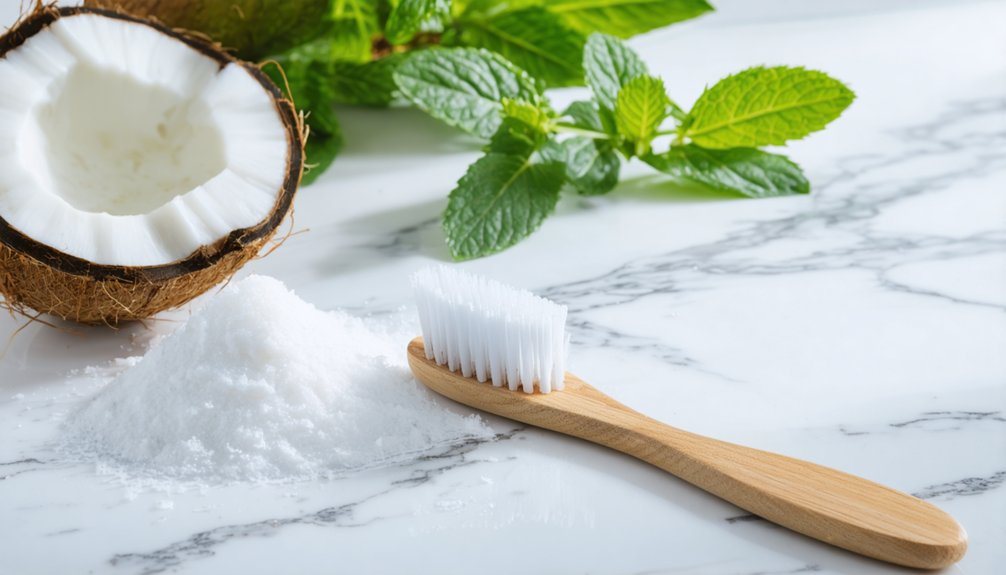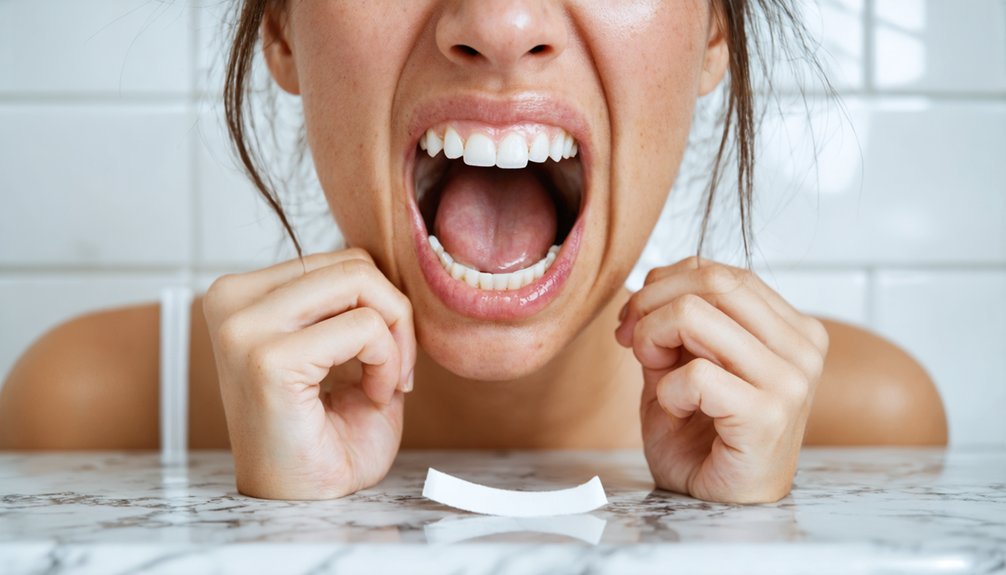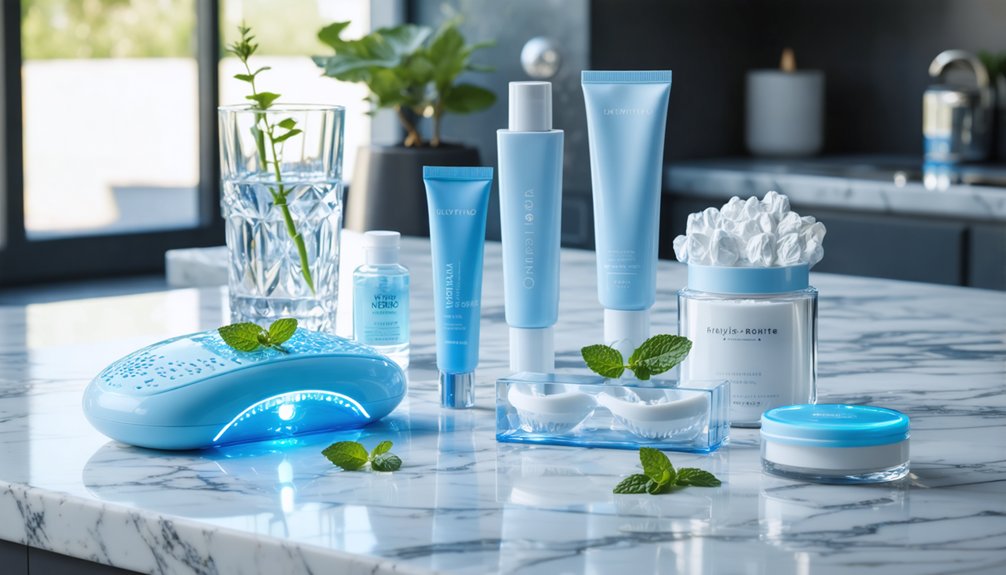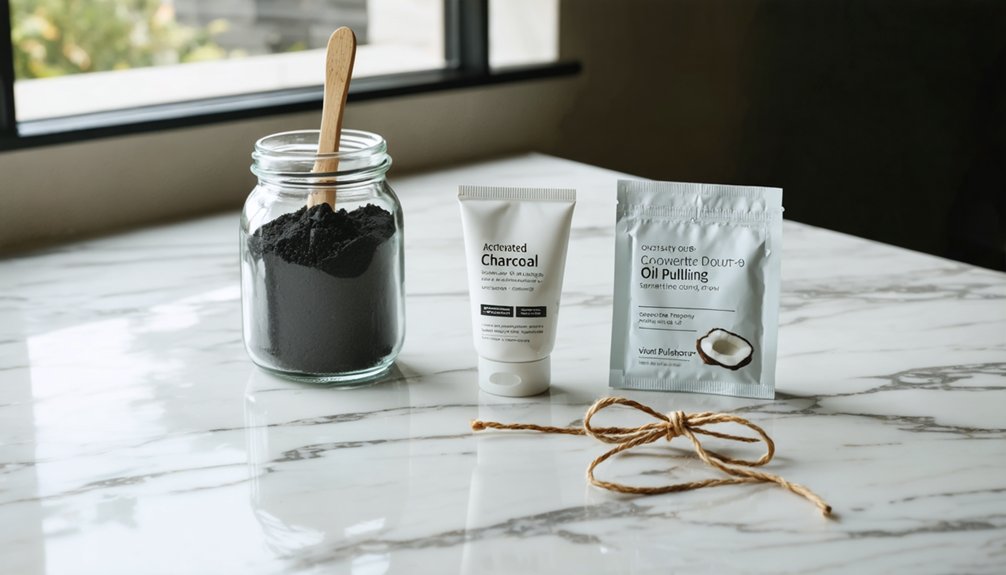If you have sensitive teeth, you can safely whiten them using products with lower peroxide concentrations, desensitizing ingredients, or professional treatments designed specifically for sensitivity. Over-the-counter options include Crest 3D Whitestrips Sensitive and Sensodyne Extra Whitening toothpaste, while natural alternatives like oil pulling offer gentler approaches. Professional treatments with custom trays and desensitizing agents provide controlled whitening under expert supervision. Understanding your specific sensitivity triggers will help determine the most effective approach for your situation.
Key Takeaways
- Use Crest 3D Whitestrips Sensitive or similar products with lower peroxide concentrations to minimize tooth sensitivity during whitening.
- Choose sensitivity-formulated whitening toothpastes containing potassium nitrate or arginine for gradual, gentle brightening effects.
- Consider peroxide-free natural alternatives like Oral Essentials Lumineux or oil pulling with coconut oil for sensitive teeth.
- Professional treatments with desensitizing agents and custom trays offer controlled whitening under expert supervision.
- Start with desensitizing toothpaste 10 days before whitening and maintain gentle brushing habits throughout treatment.
Understanding Tooth Sensitivity and Whitening
While many people desire whiter teeth, those with sensitivity must approach teeth whitening with extra caution. If you experience tooth sensitivity, you’re among the 12.5% to 50% of adults who deal with sharp pain responses to temperature changes and certain foods.
This condition occurs when worn enamel exposes dentinal tubules, making nerve endings more reactive to stimuli. Since teeth whitening products contain hydrogen peroxide which can demineralize enamel, extra precautions are necessary. Using a soft-bristled toothbrush can help protect your enamel during whitening treatments.
Understanding whitening safety starts with recognizing your specific sensitivity triggers. Since sensitivity often stems from gingival recession, enamel erosion, or bruxism, these underlying causes can impact your whitening options.
Before whitening sensitive teeth, identify your unique triggers and understand how conditions like enamel wear may affect treatment choices.
Women and adults between 38-47 years old face higher risks of sensitivity, requiring particular attention when choosing whitening treatments. The key is identifying methods that won’t exacerbate existing sensitivity while achieving desired cosmetic results.
Best Over-the-Counter Products for Sensitive Teeth
You’ll find effective whitening solutions in gentle strips like Crest 3D Whitestrips Sensitive, which contain lower peroxide concentrations to minimize discomfort.
Regular dental checkups help monitor stain removal progress while ensuring your whitening methods remain safe for your sensitivity level.
For daily care, specialized toothpastes containing potassium nitrate and stannous fluoride, such as Sensodyne Extra Whitening, can both brighten and desensitize your teeth.
Natural alternatives like Oral Essentials Lumineux offer no harsh peroxide while effectively lifting stains.
Combining these products with LED whitening kits that include desensitizing serums can provide extensive care while maintaining comfort throughout your whitening journey.
Gentle Whitening Strip Options
For those with sensitive teeth, gentle whitening strips offer a practical over-the-counter solution by utilizing lower peroxide concentrations and specialized formulations.
Leading products like Crest 3DWhitestrips Sensitive + LED Light and Crest 3D White Whitestrips Gentle Routine demonstrate effective whitening strip effectiveness while prioritizing sensitivity management techniques. The unique LED Accelerator Light enhances the overall whitening process while maintaining gentleness on sensitive teeth.
To maximize results while minimizing discomfort, you’ll need to follow specific usage guidelines.
Limit daily exposure time to 30 minutes, avoid exceeding recommended frequency, and guarantee proper strip placement to prevent gum irritation. Most users can expect optimal whitening results within 14 days to 6 weeks of consistent use.
You should also complement your whitening routine with desensitizing toothpaste post-treatment.
If you experience prolonged pain or have underlying dental issues like cavities or periodontal disease, consult your dentist before starting any whitening regimen.
Low-Peroxide Toothpaste Choices
Because sensitivity often limits whitening options, low-peroxide toothpastes offer a gentler approach to teeth brightening through carefully balanced formulations.
Contrary to sensitivity myths, you can achieve noticeable results while protecting your enamel. The low peroxide benefits include gradual whitening without the intense discomfort associated with stronger treatments.
Leading products like Sensodyne Extra Whitening contain potassium nitrate for round-the-clock sensitivity relief, while Colgate Sensitive Pro-Relief utilizes arginine and calcium carbonate for gentle stain removal. At just $9.84 per pack, Sensodyne provides an affordable solution for maintaining whiter teeth without sacrificing comfort. The SLS free formula makes it especially gentle for daily use.
For those seeking natural alternatives, Tom’s of Maine combines xylitol with mild abrasives. These formulations work through controlled peroxide levels and desensitizing agents that block nerve pain signals, allowing consistent use without compromising comfort or effectiveness.
Desensitizing Treatment Combinations
Building upon the benefits of low-peroxide toothpastes, combining multiple desensitizing treatments can maximize whitening effectiveness while minimizing discomfort.
You’ll find superior results by pairing desensitizing agents like potassium nitrate with gentle whitening products such as Crest 3D Whitestrips Sensitive or Walgreens Extreme Whitening Wraps.
Professional dentists recommend using products containing 10-35% carbamide peroxide for safe and effective at-home whitening treatments.
To achieve whitening synergy, incorporate fluoride-based products to strengthen your enamel while using PAP-based whiteners that don’t rely on peroxide.
Hard-bristled toothbrushes can worsen sensitivity and damage enamel, so always opt for soft bristles when maintaining your whitening routine.
For best results, maintain consistent use of sensitivity-reducing products between whitening sessions, and consider supplementing with natural methods like coconut oil pulling.
Always follow product instructions carefully to prevent gum irritation and maintain treatment effectiveness.
You can enhance these effects by applying desensitizing serums before whitening treatments.
Professional Whitening Treatments That Minimize Discomfort
When seeking professional teeth whitening treatments, patients with sensitivity have several carefully controlled options that maximize results while minimizing discomfort.
In-office options utilize higher-strength peroxide gels combined with desensitizing agents like fluoride or potassium nitrate to achieve dramatic results while managing sensitivity.
Take-home kits feature custom-fitted trays and lower-concentration gels for gradual whitening that’s gentler on sensitive teeth.
Laser treatments can accelerate the whitening process through controlled activation of peroxide gels, often incorporating pre-emptive desensitizing protocols to reduce potential irritation.
All professional methods benefit from expert supervision to adjust treatment parameters based on individual sensitivity levels, ensuring ideal results without compromising comfort.
Your dentist can determine which approach best suits your specific sensitivity needs while delivering the desired whitening outcome.
Natural and Gentle Whitening Methods

Several natural and gentle whitening methods offer safe alternatives for individuals with sensitive teeth seeking to brighten their smile.
Oil pulling with coconut oil can reduce bacteria and plaque that cause discoloration, while providing a non-abrasive approach to whiter teeth. You’ll need to swish the oil for 15-20 minutes daily to see gradual improvements.
For a more direct approach, you can create a mild paste using baking soda and a small amount of hydrogen peroxide. However, use this combination sparingly to prevent enamel wear.
Support these methods by reducing consumption of staining beverages like coffee and tea, while increasing crunchy vegetables in your diet. Choose sensitivity-formulated whitening toothpastes with ADA approval, and avoid acidic fruits or abrasive substances that can worsen tooth sensitivity.
Post-Whitening Care for Sensitive Teeth
If you’re experiencing discomfort after teeth whitening, you can immediately soothe sensitivity by applying desensitizing gel and drinking room-temperature beverages.
To protect your teeth long-term, use specialized toothpaste containing hydroxyapatite, which creates a protective barrier against sensitivity triggers.
You’ll also benefit from maintaining consistent hydration and following a gentle oral care routine with a soft-bristled toothbrush for at least one week post-treatment.
Soothing Immediate Discomfort Tips
Managing post-whitening tooth sensitivity requires immediate intervention through proven remedial techniques and preventive measures.
To soothe discomfort, apply desensitizing toothpaste or gels containing potassium nitrate directly to affected areas, allowing the product to sit for several minutes before rinsing. You’ll want to avoid common sensitivity triggers like extreme temperatures, acidic foods, and sugary drinks for 24-48 hours post-treatment.
Take NSAIDs preemptively before whitening and continue as needed for up to two days. Use a soft-bristled brush with gentle, desensitizing toothpaste, and rinse with fluoride or saltwater solutions to calm irritated teeth.
Wait 30 minutes after whitening before brushing to let your enamel rehydrate. If sensitivity persists beyond two weeks, consult your dentist for professional evaluation and stronger desensitizing treatments.
Long-Term Protection Strategies
Implementing long-term protection strategies after teeth whitening proves essential for minimizing future sensitivity and maintaining results.
You’ll need to incorporate multiple desensitizing techniques, including regular use of specialized toothpaste and gels that block nerve pathways.
Focus on enamel preservation by avoiding acidic and sugary foods that can erode tooth structure.
Professional whitening treatments offer better sensitivity control compared to over-the-counter options.
Strengthen your enamel by using fluoride products consistently and maintaining balanced oral care routines.
You can further protect your teeth by choosing lower-concentration whitening products and following customized treatment plans.
Remember to schedule regular dental check-ups to monitor sensitivity levels and adjust your protection strategy as needed.
These approaches will help guarantee long-lasting results while minimizing discomfort.
Signs You Should Skip Whitening Treatment

While teeth whitening can enhance your smile, certain oral health conditions signal the need to postpone or avoid treatment altogether.
You’ll need to skip whitening if you have active tooth decay, untreated cavities, or signs of enamel erosion. These whitening contraindications also include persistent tooth sensitivity, gum inflammation, or exposed tooth roots.
Your dental health status may prevent safe whitening if you’re pregnant, breastfeeding, or have significant dental work like crowns or veneers.
Watch for warning signs like bleeding gums, oral infections, or previous adverse reactions to whitening agents. If you’ve experienced lasting sensitivity from prior treatments or have periodontal disease, consider alternative cosmetic options.
Always consult your dentist before proceeding with whitening if you have any pre-existing oral conditions.
Tips for Long-Term Sensitivity Management
Successful long-term sensitivity management requires a thorough approach that combines proper product selection with strategic behavioral modifications.
Managing tooth sensitivity demands both careful choices in dental products and thoughtful changes to daily oral care routines.
You’ll want to start using toothpaste with desensitizing ingredients about 10 days before whitening and continue afterward. Focus on enamel strengthening by incorporating fluoride varnishes and using lower peroxide concentrations during treatments.
Adjust your whitening protocol by reducing application times and extending treatment duration over several weeks.
Maintain gentle brushing habits with a soft-bristled brush, and avoid rinsing immediately after using desensitizing products. Keep food and beverages at room temperature post-treatment, and skip acidic items that could compromise enamel integrity.
Regular dental check-ups will help monitor your progress and allow for early intervention if sensitivity persists.
Frequently Asked Questions
How Long Should I Wait Between Whitening Treatments if I Have Sensitive Teeth?
For ideal sensitivity management, you’ll need to wait 7-10 days between whitening treatments. If discomfort persists, extend whitening frequency to 14-30 days and consult your dental professional.
Can Certain Medications Affect Tooth Sensitivity During Whitening Procedures?
Like a shield weakened in battle, medications such as antihistamines, decongestants, and inhaled corticosteroids can increase your tooth sensitivity during whitening. Consult your dentist for proper sensitivity management before proceeding.
Is Teeth Whitening Safe During Pregnancy if I Have Sensitive Teeth?
You shouldn’t pursue teeth whitening during pregnancy due to increased sensitivity and uncertain safety risks. Instead, focus on gentle cleanings and natural stain prevention until after delivery.
Does Tooth Sensitivity From Whitening Indicate Underlying Dental Problems?
While 50% of people experience whitening sensitivity, it doesn’t usually indicate dental problems. However, if you have gum recession or enamel wear, your sensitivity causes may reflect underlying dental health issues.
Can Sensitive Teeth Become Permanently Resistant to Whitening Treatments Over Time?
Your teeth won’t become permanently resistant to whitening treatments, though repeated sensitivity may require exploring whitening alternatives. Long-term effects depend more on proper application and dental health than sensitivity alone.
References
- http://www.goochlanddentistry.com/whats-the-best-teeth-whitener-for-sensitive-teeth/
- https://pmc.ncbi.nlm.nih.gov/articles/PMC4058574/
- https://www.sensodyne.com/en-us/oral-health-tips/whitening-sensitive-teeth/what-to-know/
- https://www.drbobsdentalcare.com/is-teeth-whitening-safe-for-sensitive-teeth/
- https://www.parkcreekdentalcare.com/blog/teeth-whitening-for-sensitive-teeth-safe-options-that-work/
- https://harborcreekdental.com/whitening-sensitive-teeth-what-you-need-to-know/
- https://www.44thstdental.com/how-to-whiten-sensitive-teeth/
- https://www.goodrx.com/conditions/dental-care/is-teeth-whitening-safe
- https://healthcare.utah.edu/healthfeed/2023/12/perils-of-sensitive-teeth
- https://pmc.ncbi.nlm.nih.gov/articles/PMC11326452/



